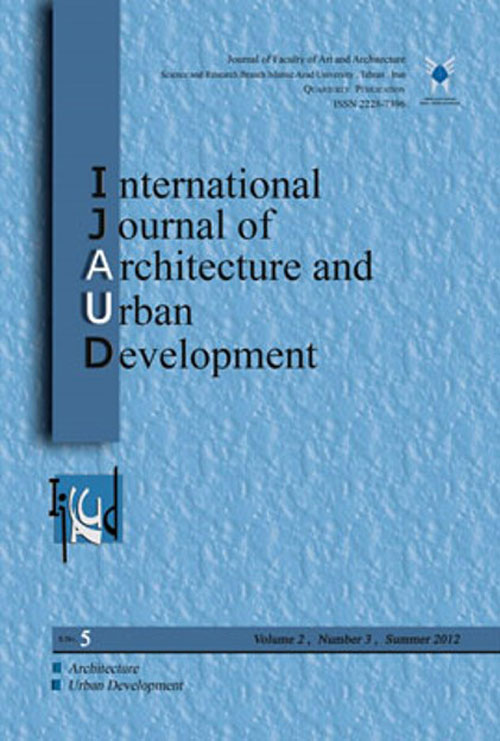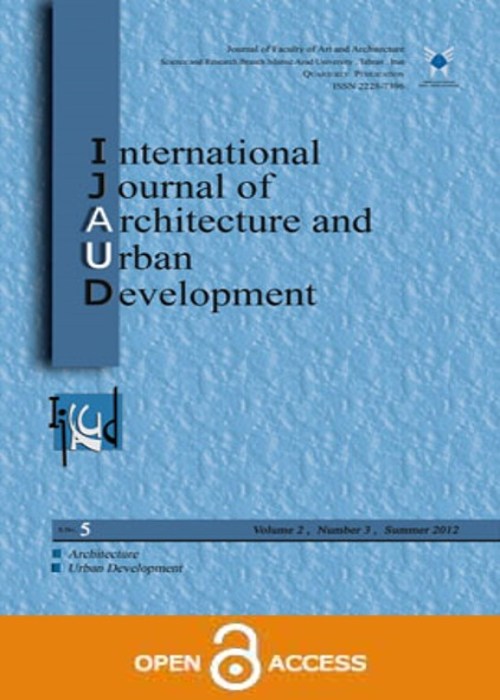فهرست مطالب

International Journal of Architecture and Urban Development
Volume:12 Issue: 2, Spring 2022
- تاریخ انتشار: 1401/02/06
- تعداد عناوین: 6
-
-
Pages 1-18
An efficient road network remains among the topical issues in the international urban development forum. This is because roads link interrelated land uses in addition to connecting them with the contiguous metropolitan areas, thus a key contributing factor for an accelerated socio-economic uplift. To sustain this, planning standards that delimit urban road reserves are usually prepared and enforced through development control to ensure that roads are exclusively maintained for their intended purpose. This study, therefore, through a case study was undertaken in Kisii Town, Kenya investigates the extent to which the unauthorized developments on urban road reserves are regulated. It was steered by the public interest theory of regulation by targeting residential developments which were proportionately and randomly drawn from the seven residential neighbourhoods. Data were collected using a high-resolution satellite image and a questionnaire. Data analysis relied on GIS, t-test, logistic regression, and linear regression. Research findings demonstrated a statistically significant difference between the approved physical planning standards that are used in regulating road reserves and the extent of compliance by developers. Compliance generally declined by a mean of four metres, signifying that the County Government of Kisii did not undertake adequate development control. Non-compliance was mostly heightened by the developers’ unawareness of the building plan approval process and that the buildings needed to be inspected during construction. This study deepens the international debate on development control by spatially and statistically illuminating how the extent of compliance with the planning standards that regulate road reserves may be empirically analyzed.
Keywords: Road reserves, development control, planning standards, Kenya, Kisii Town -
Pages 19-30
In developing countries, after decades passed from preparing urban development plans, informal settlements and urban decay are unresolved, but their scope and severity increase day by day. Therefore, instead of tracing the root of this problem in preparing and implementing plans, it should be viewed from another perspective and the hidden aspect of planning theory, i.e., the realm of power and its application to living space, mainly ignored by urban planners. The primary purpose of this study is to investigate the genealogy of urban development plans in the Abkooh neighborhood to reflect the application of bio-power in the process of spatial planning. Using the social constructivism approach and accepting the transition of the capitalist system from imperialism to the empire, the current study analyses two categories of power-knowledge: disciplinary power and bio-power and their relationship with spatial planning. Then, after describing the gray spaces, applying disciplinary power and bio-power in these spaces is discussed. Finally, Foucault's genealogical approach is performed to critically analyze the bio-power in urban development projects related to the Abkooh neighborhood. From Foucault's power-knowledge perspective, power relations seek to accumulate capital and commodify urban spaces through urban development plans and rely on disciplinary power and bio-power and using the formal spatial planning system. The research findings prove that historically, the formation of urban development plans is connected to the network of power relations. Therefore, spatial planners, besides attending planning approaches routinely learned in the academic environment, should also address power-knowledge issues.
Keywords: Power-Knowledge, Disciplinary Power, Bio-Power, Gray Space, Abkooh Neighborhood of Mashhad, Foucault's Genealogy -
Pages 31-44
This research seeks to answer what process should be done for a comprehensive analysis and study of producing urban space. The research method of the present study is influenced by the qualitative nature of the research question and to explain a conceptual framework. It has been prepared based on the analytical-descriptive method and sources. Data collection was done by documentary and library methods, and a three-step process was performed. In the first stage, document analysis and direct observation of urban spaces and review of some of the latest research and global experiences of urban space production have been used, which makes the reliability and validity of the research guaranteed by triangulation of evidence sources. In the second stage, an analytical framework related to producing and reproducing urban space, which includes four general layers, has been developed by summarizing and analyzing them. Then, in the third stage, the sub-layers of this framework with emphasis on power relations (influence) of related actors have been refined, and the proposed model of space production has been developed. The production and reproduction of space in the city consist of 4 layers. These four stages must be examined to study the production or reproduction of a specific area. 1-Geographical context (natural context), 2-Time, 3-Formal urban planning system, 4-Social organization or networks of actors (or stakeholders). In this study, a model for studying the production of different urban spaces has been proposed from the collection of findings and analyses.
Keywords: Space production, space production process, Urban space, Lefebvre, space production layers -
Pages 45-58
The primary purpose of this research is to investigate the effect of land-use spatial configuration and street network structure on people's mental safety in local contexts. A review of various theoretical frameworks demonstrates a feasible causal relationship between morphology and the psychological dimension of safety. Hence, this paper emphasizes the assessment of the effect of urban land configuration, which influences the movement behavior of residents, on the psychological safety of residents of mahallas. This research begins with a review of the literature to identify the gap in the theoretical literature and carry out the problem-finding to obtain an analytical model of research to examine the proximity of uses introduced in three types of proximity. Then, parameters will be evaluated in this framework using the software. The research investigates variables' interactions based on Space Syntax, spatial parameters of connectivity value, spatial integration/segregation, attractive uses, movement behavior, density, and mahallas' main and peripheral centers. The results indicate that the safety of urban areas depends on how uses are located and, consequently, on the movement behavior of users'. The comparison of the two mahallas showed that compared to Bazar, Manzarie offers a better arrangement of uses in the inner axes and sub-nodes. It establishes an appropriate spatial relationship between its various gravity points, thus bringing about various movement behaviors. Therefore, it displaces more people in the axes connecting different uses, allowing surveillance and spatial dynamics.
Keywords: Safety, Land Use, Spatial Structure, Urban Mahallas layout, Movement Behavior, Space Syntax -
Pages 59-72
Providing the conditions of residential neighborhoods to enhance residents' quality of life has always been an issue of great for urban experts and policymakers of various fields. According to the extensive research in this field, addressing quality of life indicates its importance in residential neighborhoods. The present manuscript evaluates and prioritizes the indicators that improve the quality of life based on the review and analysis of experts (in architecture, landscape architecture, urban design, and planning). The strategy of this study is the correlation with a descriptive-analytical approach to evaluate and prioritize the indicators of quality of life, four of which have been identified for review by experts, namely Institutional; Economic; Social and Environmental satisfaction. A total of 22 experts answered the questions, and the findings were analyzed using the DANP technique. The findings indicate that the components of "institutional satisfaction" and "social satisfaction" have the most significant impact on enhancing residents' quality of life, respectively, from the perspective of experts. In addition, based on the weight of the obtained components, "policy-making and decision-making of organizations and institutions" in the neighborhood and "access to health facilities and services" were ranked as the first and last practical components, respectively. Therefore, strategies can be developed based on the prioritization of experts, such as strengthening social and infrastructural services and facilities (institutional); Residents' decision-making and participation in neighborhood management (social); provision of participatory housing (economic), and development of open and green space (environmental)
Keywords: Quality of Life, Residential Satisfaction, Residential Neighborhoods, Expert Evaluation, NeighborhoodSustainability -
Pages 73-82
The present study aimed to discover the memorabilia aspects and evaluate the effectiveness level on promoting the feeling of intimacy of inhabitants in localities to their biological scopes. The feeling of intimacy is a multidimensional issue for which various aspects are compelling. Based on the recent studies, memory as one of the criteria examines the feeling of intimacy toward their habitats. To assess the theoretical patterns, three locations were chosen as a case study among old localities, including Ishaq Beyg, Blackstone, and chicken market and three areas of irrigation, Havabord, and Eslahnezhad among new localities of Shiraz. A consistent questionnaire was distributed among them. This study includes a practical method is and developed based on correlation and descriptive-analytical technique. The questionnaires data were assessed by SPSS software and Spearman Correlation Coefficient tests, ANOVA, Tukey, Samples, and Paired Test Samples T and Pearson Correlation Coefficient. Our results indicated the homogeneity of particular localities in old and new contexture based on the individual feature's similarities and importance of memory aspect on the promotion of intimacy in all localities. Thus, social memories are more effective than skeletal ones in promoting the inhabitant's intimacy in localities.
Keywords: Intimacy, Vitality, area, Shiraz city, inhabitable environment


